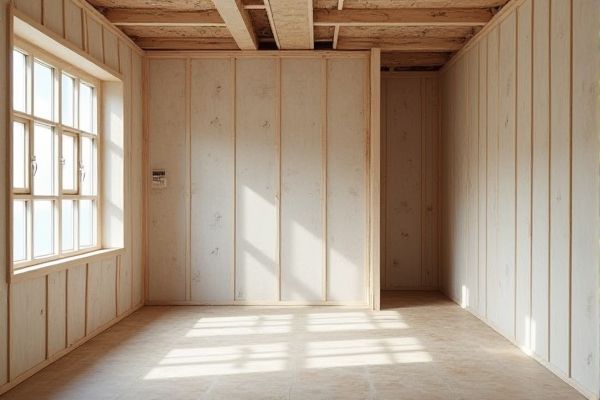
Insulated wall panels offer superior thermal efficiency and moisture resistance compared to traditional drywall, making them ideal for energy-saving and durable construction projects. Explore the full article to understand which option best suits your building needs and preferences.
Table of Comparison
| Feature | Insulated Wall Panels | Drywall |
|---|---|---|
| Thermal Insulation | High R-value, excellent energy efficiency | Low R-value, requires additional insulation |
| Installation Speed | Fast, pre-fabricated panels | Moderate, involves multiple steps |
| Durability | Highly durable, moisture and impact resistant | Less durable, prone to damage and moisture |
| Cost | Higher upfront cost | Lower initial cost |
| Soundproofing | Better sound insulation | Moderate soundproofing |
| Maintenance | Low maintenance | Requires regular patching and painting |
| Environmental Impact | Energy efficient, reduces carbon footprint | Higher environmental impact, less energy efficient |
| Typical Applications | Commercial buildings, cold climates | Residential, interior walls |
Introduction to Insulated Wall Panels and Drywall
Insulated wall panels consist of rigid foam insulation sandwiched between metal or composite facings, offering superior thermal resistance and moisture control compared to traditional drywall. Drywall, composed primarily of gypsum plaster pressed between paper layers, serves as a cost-effective and easy-to-install interior surface but lacks significant insulation properties. The choice between insulated wall panels and drywall impacts energy efficiency, installation time, and overall building envelope performance.
Key Differences Between Insulated Wall Panels and Drywall
Insulated wall panels offer superior thermal insulation and energy efficiency compared to drywall, which primarily serves as an interior finishing material without insulation properties. These panels integrate insulation directly within the wall system, reducing heat transfer and improving soundproofing, while drywall requires additional insulation materials for similar benefits. Your choice depends on whether enhanced insulation and structural efficiency or cost-effective interior finishing is the priority.
Thermal Efficiency: Insulated Panels vs Drywall
Insulated wall panels provide superior thermal efficiency compared to drywall by combining rigid insulation materials with structural surfaces, significantly reducing heat transfer and enhancing energy savings. Drywall alone offers minimal insulation, often requiring additional layers or insulation materials to achieve comparable thermal performance. Your building's energy efficiency and indoor comfort improve substantially when choosing insulated wall panels over traditional drywall.
Soundproofing Capabilities Compared
Insulated wall panels offer superior soundproofing capabilities compared to traditional drywall due to their dense core materials, such as foam or mineral wool, which effectively absorb and block sound waves. The continuous barrier created by insulated panels reduces airborne noise transmission, making them ideal for environments requiring enhanced acoustic privacy. In contrast, standard drywall often requires additional insulation or soundproofing treatments to achieve similar levels of noise reduction.
Installation Process and Time Requirements
Insulated wall panels offer a faster installation process compared to drywall due to their pre-fabricated nature, reducing labor time and minimizing on-site assembly. Drywall installation involves multiple steps including framing, taping, mudding, sanding, and painting, which extend the overall project duration. The integrated insulation in wall panels eliminates the need for separate insulation installation, further accelerating the build timeline.
Cost Comparison: Upfront and Long-Term
Insulated wall panels typically have a higher upfront cost compared to drywall due to advanced materials and integrated insulation properties. However, these panels offer significant long-term savings on energy bills by reducing heating and cooling expenses, which can offset initial investment over time. Your choice between insulated wall panels and drywall should consider both immediate budget constraints and future energy efficiency benefits.
Durability and Maintenance Needs
Insulated wall panels offer superior durability compared to drywall due to their resistance to moisture, impacts, and temperature fluctuations, making them ideal for environments prone to wear and tear. Maintenance requirements for insulated panels are minimal since they are less susceptible to mold, cracks, and dents, reducing the need for frequent repairs or repainting. Drywall requires regular upkeep to address issues like water damage, holes, and surface imperfections, which can escalate maintenance costs over time.
Design Flexibility and Aesthetics
Insulated wall panels offer superior design flexibility compared to drywall, allowing for seamless integration of modern architectural elements and varied finishes such as textured surfaces or vibrant color options. Their rigid structure supports innovative designs including curved walls and large spans without additional framing, enhancing your ability to create visually striking interiors. Drywall, while versatile, often requires extra treatments and reinforcement to achieve similar aesthetic effects, making insulated panels a more efficient choice for sophisticated design needs.
Environmental Impact and Sustainability
Insulated wall panels offer superior environmental benefits compared to drywall due to their energy efficiency and reduced thermal bridging, which significantly lowers heating and cooling demands. These panels often incorporate recycled or renewable materials, enhancing sustainability by minimizing resource depletion and construction waste. Choosing insulated wall panels for Your project supports a greener building approach with better long-term energy savings and lower carbon footprints.
Best Applications: When to Choose Each Option
Insulated wall panels are best suited for environments requiring superior thermal performance and moisture resistance, such as commercial cold storage, industrial facilities, and energy-efficient buildings. Drywall is ideal for interior spaces in residential and office settings where cost-effectiveness, ease of installation, and flexibility in design and finishing are priorities. Selecting insulated wall panels enhances insulation and durability, while drywall offers versatility and affordability for typical indoor wall applications.
 homyna.com
homyna.com